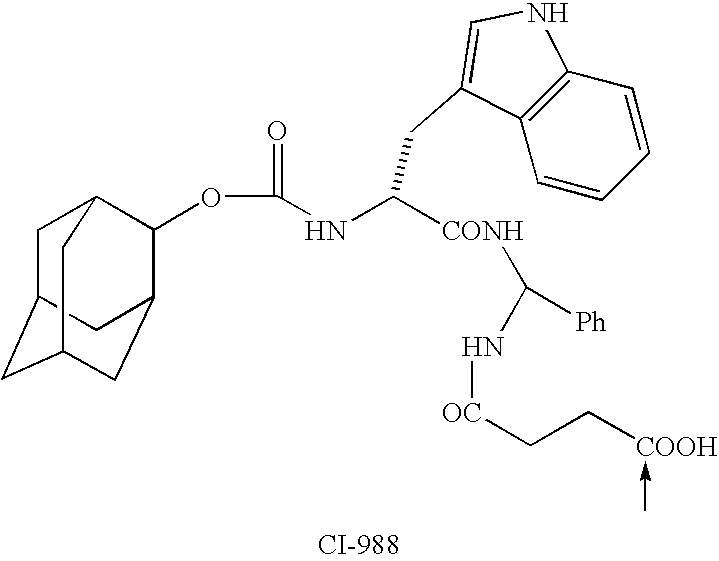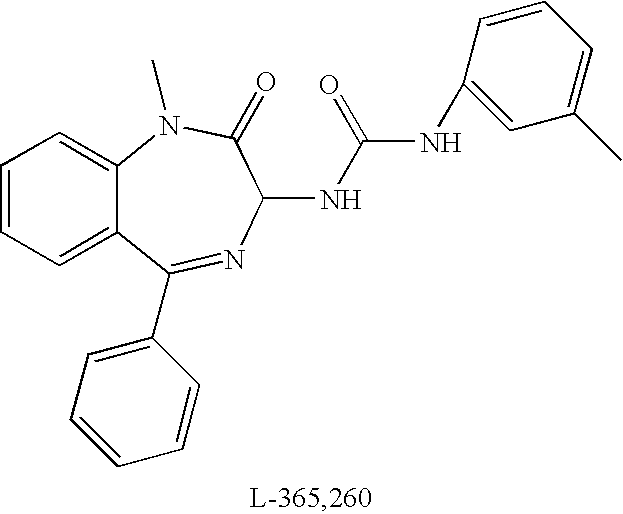Conjugates of ligand linker and cytotoxic agent and related composition and methods of use
a technology of cytotoxic agent and ligand, which is applied in the direction of gastrin/cholecystokinin, drug composition, peptide/protein ingredient, etc., can solve the problems of systemic toxicity of drugs, dose limitation, most intractable problems
- Summary
- Abstract
- Description
- Claims
- Application Information
AI Technical Summary
Problems solved by technology
Method used
Image
Examples
example 1
[0036] This example demonstrates a method of synthesizing a conjugate of the present invention.
[0037] Solid Phase Peptide Synthesis of N,N-dimethylvaline (Dov)-Val-N-methylvaline (Me Val)-Pro-Pro-OH (Cemadotin derivative with free carboxy-terminus): Preloaded 9-fluorenylmethoxycarbonyl-proline-NovaSyn TGT (Fmoc-Pro-NovaSyn TGT) resin (0.80 g) was allowed to swell in N-methylpyrrolidone (NMP) for 2 hours prior to cleavage of the Fmoc protecting group. After deprotection with 20% piperidine in NMP, the second Pro residue was coupled via ABI 433 peptide synthesizer (Applied Biosystems, Foster City, Calif.) using 2-(1H-Benzotriazole-1-yl)-1,1,3,3-tetramethyluronium hexafluorophosphate (HBTU) and N-Hydroxybenzotriazole (HOBt) as coupling reagents. The remaining amino acid residues were coupled manually using 2-chloro-1,3-dimethylimidazolidium (CIP), 1-hydroxy-7azabenzotriazole (HOAt), and diisopropylethylamine (DIPEA) activation mixture (Akaji et al., Tetrahedron Letters 35: 3315-3318 (...
example 2
[0041] This example demonstrates the synthesis of conjugates comprising the hemiasterlin derivative, SPA110, and the gastrin decapeptide.
[0042] SPA 110 was prepared essentially as described previously (see R. Andersen et al. (WO99 / 32509)). SPA is a tripeptide that consists of three unnatural amino acids: (2E,4S)-2,5-dimethyl-4-(methylamino)-2-hexanoic acid, L-tert-leucine, and (2S)-N-methyl-3-methyl-3-phenylbutanoic acid. Due to significant steric difficulties, conjugation of all three was performed in solution rather than on solid phase. The resulting protected derivative of SPA 110 was attached to a peptide-ligand-linker sequence on a resin. Detailed description of the preparation of all intermediates are as follows.
Preparation of N-(tert-Butoxycarbony)-N-methyl-L-valine-N′-methoxy-N′-methylamide (MD006)
[0043]
[0044] N,N-diisopropylethylamine (1.9 ml, 10.8 mmol) and (benzotriazol-1-yloxy)tripyrrolidinophosphonium hexafluorophosphate (PyBOP) (5.63 g, 10.8 mmol) were added to the...
example 3
[0096] This example describes the activity of the conjugate comprising the hemiasterlin derivative, SPA110, the linker VLALA, and the gastrin decapeptide.
[0097] This conjugate had relatively low activity (IC50=1 μM) when tested on gastrin receptor-expressing 3T3 cells in accordance with the methods of Example 7. The low activity observed appears to be due to insufficient processing of the conjugate in the lysosomes. Hydrolysis of the conjugate with two major lysosomal proteases, namely cathepsin B and cathespin D, generated mostly pentapeptide or SPA110 extended by Val-Leu on the C-terminus. Toxicity testing of synthesized SPA110 extended by Val-Leu on the C-terminus confirmed the observed results. Further enzymatic processing of HTI conjugates does not occur because proteases are not able to cleave after the β amino acid of HTI-286.
PUM
| Property | Measurement | Unit |
|---|---|---|
| Electric charge | aaaaa | aaaaa |
| Molar density | aaaaa | aaaaa |
| Molar density | aaaaa | aaaaa |
Abstract
Description
Claims
Application Information
 Login to View More
Login to View More - R&D
- Intellectual Property
- Life Sciences
- Materials
- Tech Scout
- Unparalleled Data Quality
- Higher Quality Content
- 60% Fewer Hallucinations
Browse by: Latest US Patents, China's latest patents, Technical Efficacy Thesaurus, Application Domain, Technology Topic, Popular Technical Reports.
© 2025 PatSnap. All rights reserved.Legal|Privacy policy|Modern Slavery Act Transparency Statement|Sitemap|About US| Contact US: help@patsnap.com



